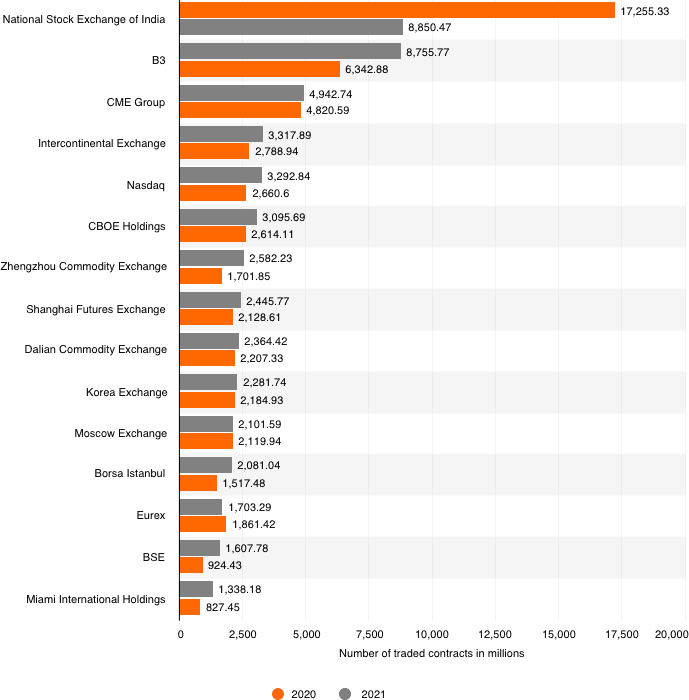If you’ve been trading futures and options for some time, chances are you know all about the CME Group. It is one of the world’s largest and most popular derivatives exchanges, with a market cap of over $60 billion and millions of contracts traded daily.
What Does the CME Group Do?
For those not in the know, CME (Chicago Mercantile Exchange) Group Inc. is the world’s leading financial derivatives marketplace. Together with its subsidiaries, it operates as a securities and commodity exchange, offering futures and options contracts trading.
The global derivatives market is a multi-trillion-dollar marketplace, facilitating the exchange of financial instruments that derive their values from underlying assets. On average, the CME Group handles over three billion contracts worth around $1 quadrillion per year.
Traders and investors can access a wide range of futures and options contracts for global benchmark products across various asset classes on CME Group. These include equity indexes, agricultural commodities, real estate, metals, energy, interest rates, foreign exchange, and even the weather.
Through its CME Globex electronic trading platform, CME Group brings together buyers and sellers from all over the world. Players in the derivatives market often use historical and live data from the CME Group to measure performance across global markets.
The company also provides clearing, settlement, cleared swaps products, risk mitigation, and trade processing services — for exchange-traded contracts and over-the-counter (OTC) derivatives transactions.
Is It Still the Largest Derivatives Exchange?
Not anymore. For the past three years, that title has belonged to the National Stock Exchange (NSE) of India. We measure the size of a derivatives exchange by the number of contracts traded in a given year.
As of 2022, CME Group ranks third among the world’s largest derivatives exchanges.

CME Group History
The story of the CME Group began in 1848 with the creation of the CBOT (Chicago Board of Trade) futures exchange in Chicago. Next followed the launch of the Chicago Butter and Egg Board, the company that would later become the Chicago Mercantile Exchange (CME) Clearing House in 1898.
Over the years, CBOT and CME continually evolved, launching new futures products, including pioneering electronic futures trading in 1987.
In 2002, CME became the first U.S. exchange to go public with its stock listed on the New York Stock Exchange (NYSE). A year later, CBOT signed an agreement with CME to use its clearing services to clear its products.
A few more agreements followed over the next few years, including the decision to merge CBOT and CME into a single company. It became official in 2007 and led to the formation of CME Group Inc.

Source: cmegroup.com
Over the last 20 years, CME Group continued to make global advancements, including acquiring the New York Mercantile Exchange (NYMEX) in 2008. The exchange also entered into a strategic partnership with BM&FBOVESPA (Bolsa de Valores de São Paulo) and the Brazilian Mercantile & Futures Exchange (Bolsa de Mercadorias e Futuros), also known as B3, the largest derivatives exchange in Latin America.
CME Group also continued expanding its product range by adding new asset classes. For instance, in September 2022, the company announced the launch of Ether options trading to complement its Ether futures market, which has already increased over 43% in average daily volume year over year.
CME Regulation
The Commodity Futures Trading Commission (CFTC) regulates the CME Group. The CFTC is the official authority in charge of overseeing all commodities and derivatives trading in the United States.
Among its many responsibilities, the CFTC conducts risk surveillance of derivatives trades, regulates trading in virtual assets, investigates market manipulation, and maintains oversight over market players.
What Assets Does The CME Group Offer?
CME Group is the world’s most diverse derivatives marketplace, made up of four prominent exchanges — CME, CBOT, NYMEX, and COMEX (The Commodity Exchange). Each one brings a unique set of global benchmarks across major asset classes to create a robust marketplace for all types of traders and investors.
To further expand its presence and drive global growth and commerce, CME Group has partnered with a number of exchanges, including B3, Dubai Mercantile Exchange, Minneapolis Grain Exchange, Singapore Exchange Limited, and Bursa Malaysia Derivatives Berhad.
It also maintains strategic relationships and licensing agreements with Google, Nasdaq, FTSE Russell Indexes, Nikkei Inc., and S&P Dow Jones Indices.
To better understand the distribution of the various asset classes across the CME Group’s exchanges, it’s essential to look at the role of each exchange in the overall marketplace.
Chicago Mercantile Exchange (CME)
The Chicago Mercantile Exchange is a designated contract market that offers a wide range of products. Its first-ever futures contract was on frozen pork bellies and was launched in 1961.
However, its standout feature is that it is the only futures exchange that offers derivatives on the weather. Traders can bet on weather events, such as rainfall, heat waves, cold temperatures, etc.
The seller of the futures contract agrees to bear the risk of disasters over a given period in exchange of premium payments from the buyer. If no damages occur before the contract expiration, the seller makes a profit. On the other hand, if there is a weather-related disaster, the buyer of the contract gets the agreed amount.
The financial instrument is quite popular. In 2020, CME recorded over 1,000 weather-related contracts per day and futures and options notional values of $750M and $480M, respectively.
Chicago Board of Trade (CBOT)
The CBOT was founded to help farmers and commodity consumers manage risks better by eliminating price uncertainty in buying and selling agricultural products, including corn, wheat, and livestock.
Because of its railroad infrastructure and proximity to agricultural heartlands, Chicago was the ideal exchange location.
Over time the CBOT added more products to its marketplace, such as energy, gold, silver, and U.S. Treasury bonds. At the time of its merger with the CME in 2007, the CBOT brought a suite of derivative financial instruments, including agricultural commodities, interest rates, and equity index products, thereby expanding the existing offerings of CME Group.
Many of the standardized terms and market regulations used in the futures market originated during the early days of the CBOT. For instance, it instituted formal trading rules that covered margin and delivery procedures in 1865. Three years later, the CBOT banned “corners,” making it the first known attempt to regulate market activities and deter manipulation.
Commodity Exchange (COMEX)
COMEX is the world’s most prominent futures and options exchange for trading metals, such as gold, silver, aluminum, and copper. It was founded in 1933 through a merger among four New York-based exchanges — the National Metal Exchange, the New York Hide Exchange, the Rubber Exchange of New York, and the National Raw Silk Exchange.
In 1994, COMEX merged with the New York Mercantile Exchange (NYMEX), becoming its official metals trading division. The exchange doesn’t supply metals but instead acts as an intermediary for metals suppliers worldwide.
It’s important to note that metals futures contracts are mainly used for hedging and are, therefore, not often physically delivered. Most contracts are simply bought or sold on the promise and knowledge that the metal exists. This makes it a highly liquid metals market.
In 2008, the CME Group acquired the NYMEX and, by extension, its COMEX division. This expanded the CME Group’s suite of metal products to include palladium, platinum, steel, and also FTSE 100 index options. Today, COMEX is the primary clearinghouse for metal futures and options contracts offered by the CME Group, all of which are traded in standardized and mini and/or micro contract sizes.
New York Mercantile Exchange (NYMEX)
NYMEX is a commodities trading exchange based in Manhattan, New York. It also maintains offices in other cities across the globe, including Boston, Washington DC, Dubai, London, and Tokyo.
Following its 1994 merger with COMEX, NYMEX became the largest physical commodity exchange at the time, facilitating the exchange of various metals, energy, and agricultural commodities. The exchange’s contribution to the CME group from its 2008 acquisition included a wide selection of oil, gas, coal, metals, and agricultural commodities contracts.
NYMEX retained a small trading pit to carry on its Open Outcry trading system until 2016, even though electronic trading on the exchange was already possible since 2006 through CME’s Globex electronic trading platform.
Trading CME Futures at Earn2Trade
Before trading on the world’s leading derivatives marketplace, it’s important to know what you’re doing. While futures and options trading can be hugely profitable, it can also lead to huge losses if you go in unprepared.
Also, it’s often hard for individual traders and investors to raise sufficient capital to trade CME futures, as most trades require tens or even hundreds of thousands of dollars.
To help you better prepare and access trading capital, consider becoming a professional futures trader on Earn2Trade.
Through the Trader Career Path, The Gauntlet™, and The Gauntlet Mini™ programs, Earn2Trade enables skilled traders to buy and sell CME futures with a funded account. This means you don’t have to put up your own money to trade, and you get to retain up to 80% of the profits.
Also, the programs can save market participants the hassle of obtaining an official license before they are allowed to trade since they’ll be operating under Earn2Trade. If you want a career as a futures trader, this is a great path to follow. Begin your professional journey with Earn2Trade today.

